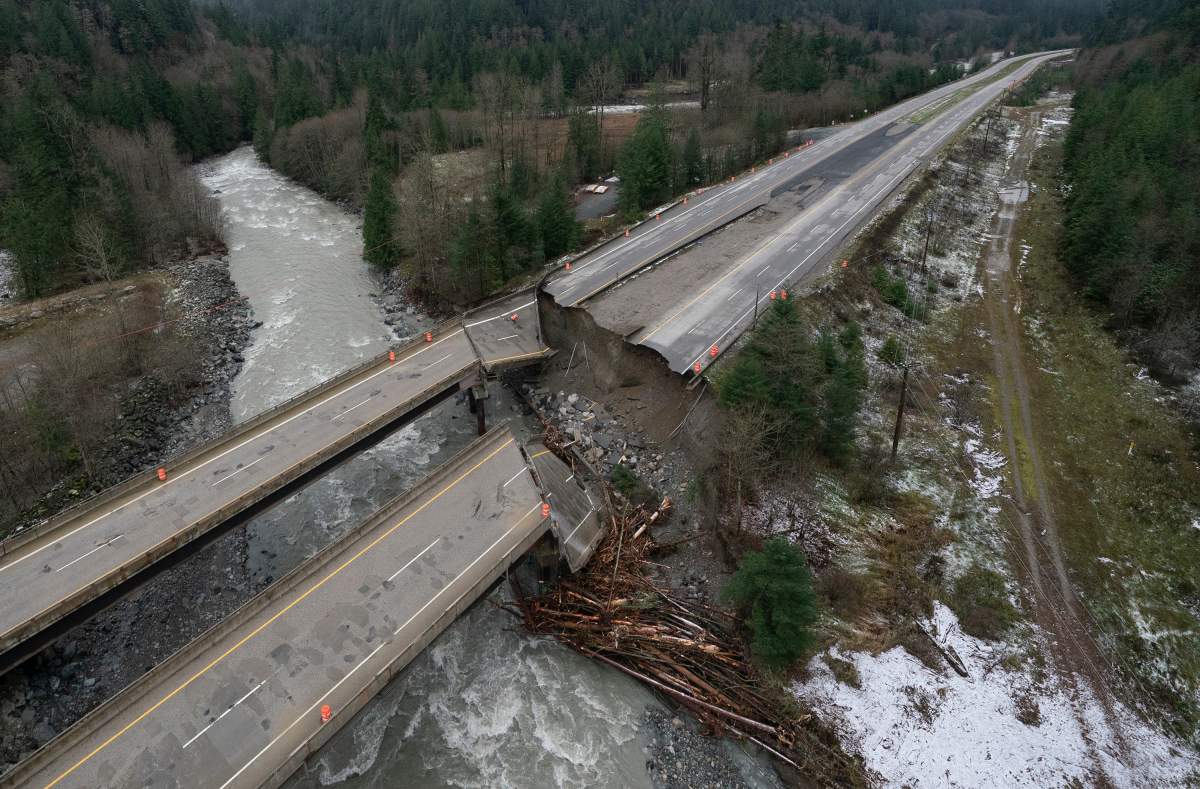In the past two weeks, Canadians have seen the damage severe rainfall can cause to the country’s infrastructure, be it washed-out roads or destroyed dikes.

The rainstorms in British Columbia and Atlantic Canada have impacted livelihoods, with damaged highways and rail lines cutting off communities and hampering key supply chain routes.
Rebuilding infrastructure like roads quickly is vital, but with climate change threatening severe weather events in the future, it’s no easy fix, experts say.
“It’s basically like a new design — only you’re running around with your hair on fire trying to do it faster than you normally would,” said Keith Porter, chief engineer with the Institute for Catastrophic Loss Reduction.
“Maybe that costs a little bit more, but in light of the disaster, you may very well be willing to pay more for the faster construction.”
Unprecedented rainfall from atmospheric rivers in B.C. and the Maritimes has dropped hundreds of millimetres worth of rain — surpassing in days the totals some regions see in a whole month.
Repairs to infrastructures are underway in B.C. even as the region prepares for another series of storms. The cost of the flooding damage from last week alone could make it the most expensive natural disaster in Canadian history.
Three B.C. municipalities sustained heavy damage: Abbotsford, Merritt, and Hope. Heavy rains and mudslides caused extreme damage to the Coquihalla Highway between Hope and Merritt.
While officials originally directed travellers to use Highway 3 to Princeton from Hope as an alternative, that area suffered a new washout Monday afternoon and has been reduced to a single lane for essential traffic only.
Elsewhere, some roads have reopened with caveats, but aren’t in any way considered repaired.

In Port-aux-Basques, N.L., significant repairs are underway on many roads, including the critical Trans-Canada Highway, which has been virtually impassable due to rain-related damage.
Though water levels have subsided, the work is only just beginning. Crews are bringing in materials and heavy equipment to build new culverts, a structure found underneath roadways used to channel water.

Get daily National news
“This is not a 48-hour fix,” said Elvis Loveless, minister of transportation and infrastructure, on Wednesday.
“It’s a big storm, we know that, but our crews are ready out in the elements. It’s a challenging one, but one that we’re ready for, and hopefully, over time, we can get the roads operational and back to somewhat normal.”
Experts say when it comes to repairing infrastructures following extreme weather events, time is of the essence.
Glenn Milner, engineering and climate risk lead at the Climate Risk Institute, told Global News that after the impacted area is deemed safe, engineers need to investigate what went wrong and determine how to fix it.
“Was it an underpinning culvert under the road, or was it simply a matter of the capacity of the system being overwhelmed and that caused degradation of the material?” he said.
“(It’s) about learning what caused the issue, but also recognizing that these things have far-reaching consequences on the supply chain and on the economy.”
Once that is done, then the design for the fix can begin, Porter explained.
If engineers decide to place the road in the same spot, they need to reinforce the terrain and structure, and find a contractor who has the resources to do the work.
“You want the contractor to be able to hit the ground as fast as possible as soon as the design is done,” Porter said.
“Or maybe you even have the designer designing the thing in stages so that the contractor can be building the first part even before you’re finished with the total design.”

While this work is being done, engineers can assess if there is an alternate route available for the movement of goods and people, Milner said.
For instance, that could be local roads that are designated emergency routes, or seaways for coastal communities that can use vessels for transportation.
That’s what’s happening in Newfoundland. With the main highway to Port-aux-Basques closed, the Crown corporation that operates ferry service to the town from Nova Scotia said Thursday it will temporarily reroute the crossing to Argentia in eastern Newfoundland so that people and supplies can reach the province.
While crews work to get repairs done quickly, they should also be factoring in how to improve the product, Milner said.
“We have to figure out how in these instances — when we’re responding and reacting to failure — is there an opportunity to learn and to bring us to a higher standard?” he said.
“The whole process itself can be quite rapid, but I think it’s important to pause and also think about the climate, what actually caused this failure, and actually look at the extreme weather event that led to it.”
Porter echoed Milner’s comments, saying engineers should be designing infrastructure to adapt to the climate “75 to 100 years from now.”
“If you look at what the climate going to be 75 to 100 years from now, then that’s what you design for so the thing works 100 years from now and doesn’t get washed out,” he said.
“If we think about it that way, we can invest today to make sure that our children and our grandchildren reap the rewards of that investment in their time, so that they don’t suffer the way that we’re suffering now.”
— with files from The Canadian Press.










Comments